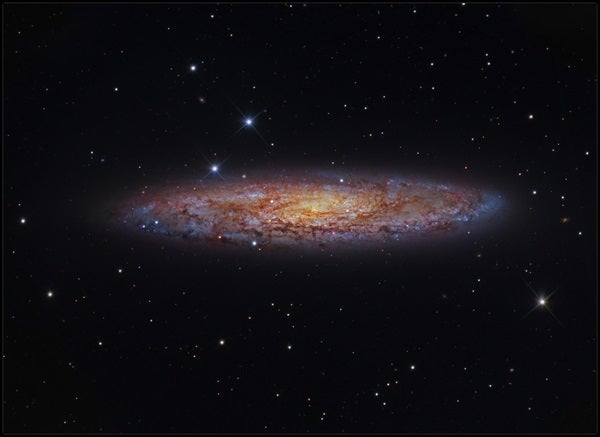The Silver Dollar or Sculptor Galaxy is the brightest deep-sky object in the diminutive constellation Sculptor. NGC 253 is highly inclined at 78° from face-on, and doesn’t have distinct arms across its broad, 27.5′ by 6.8′ disk. Recent imaging shows a poorly developed bar and two concentrated arms amidst a disk rich in dark and emission nebulae.
At 8th magnitude, NGC 253 can be seen in binoculars and is about 7° south of Beta (β) Ceti. Slightly larger optics may allow you to note the small nuclear brightening, and even larger apertures will reveal some granulation from the abundance of dust clouds. Without distinctive arms, the mottled disk is worthy of scrutiny.
NGC 253 is located 11 million light-years from us and is the largest in the Sculptor Galaxy Group, one of the closest galaxy groups to ours. It is so close that other members are scattered in other constellations, including NGC 247 in Cetus and NGC 625 in Phoenix. This group is dominated by low-mass irregular galaxies similar to the Large and Small Magellanic Clouds; its members are best seen in large optics because they range from 10th to 16th magnitude.
The Silver Dollar Galaxy is about as far from the plane of the Milky Way as possible, located around 2° from the South Galactic Pole. That means we are looking through a minimum amount of interstellar dust. The nearest bright deep-sky object (1.8° southeast) is the magnitude 8 globular cluster NGC 288. It’s worth noting that although most globulars are close to the Milky Way’s galactic plane, at 37′ northeast of the South Galactic Pole, NGC 288 is about as far as a globular cluster can get in apparent position (but not physical distance) from the plane.
Make sure to explore Astronomy’s full list of 101 cosmic objects you must see. New entries will be added each week throughout 2022.
To get the latest astronomical news and observing content delivered directly to your door, subscribe to Astronomy magazine today!










